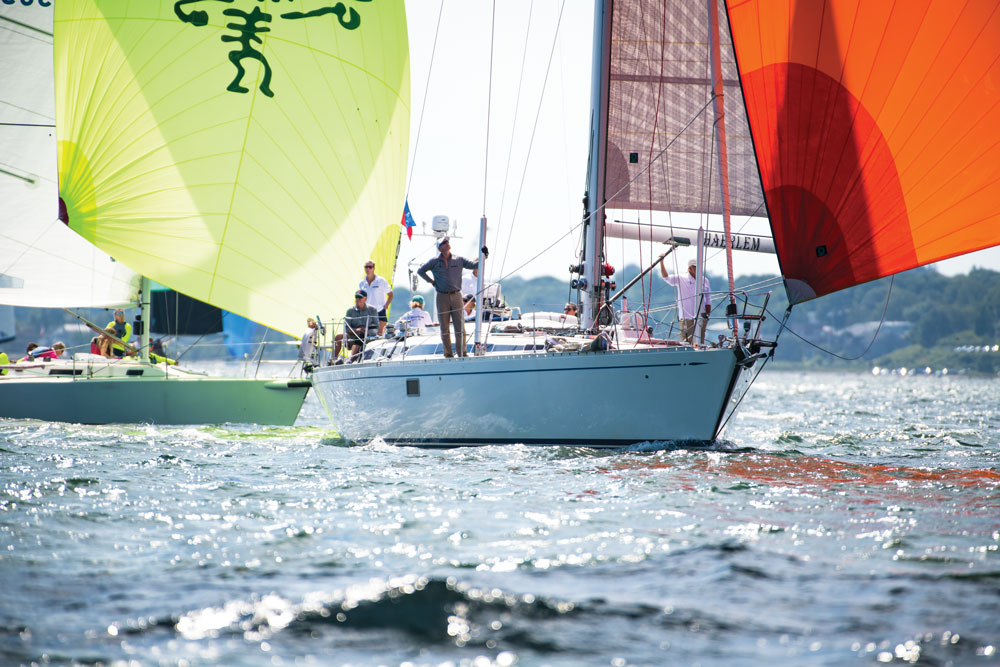Asymmetric spinnaker skills
This sail can be key to getting downwind fast with a few skills and a bit of practice
As the boat rounds the mark, the skipper calls for the bear away and then for the sail to be hoisted. The halyard is jumped at the mast and tailed by the pit person while another crewmember goes to leeward to assist in pulling the clew aft to straighten the foot for a clean hoist prior to the trimmer taking control. Once the sail is at the full hoist position, the mast person calls “made” and the bow should be in the born away position, approximately 140 degrees apparent wind angle. The asymmetrical will fill and the trimmer eases the sail to its normal trimmed position. A tip when you are practicing, mark the optimum sheet position so that the trimmer can preset the sheet to this gross trim position so that when the sail fills it is already nearly perfectly trimmed.
Trimming

Trimming the sail is quite simple. Just like any other sail, it will tell you when it’s happy and when it’s not, you just have to learn what to look for. Like a jib, if the asymmetrical starts luffing it needs trimming. Unlike trimming a jib, you’ll need to watch the luff of the asymmetrical for a curl, rather than the leech of the jib. To start your trim, bring the sail in until the luff of the asymmetrical is smooth and stops luffing. Once the spinnaker is full, start to slowly ease the sail back out to the point where it barely starts to curl along the luff. And then, you guessed it, trim in again. This is your range of trim. Keep pushing the ease all the way to curl for optimum trim.
Keeping the asymmetrical over trimmed is slow, so always remember that the ease is equally as important as the trim. If the boat feels slow and the sail doesn’t seem to be drawing as it should, then try easing more. The worst that can happen is the luff curls and you pull it back in. Consider, too, that the trimmer is really the helmsman’s guide when going downwind, so make sure your communication between each other is clear, frequent and precise. Communicate what you feel in the spinnaker or on the helm. For example, if you have a lot of pressure in the sail you could ask the helmsman to “press” —turn a little further downwind. If the sail feels light, ask the driver to come up. Create a pre-determined number amount, “up one” or for more up, “up two.” It’s simple, but it will keep the boat moving and the clear communication will generally mean less trimming is needed.
Jibing
The jibe is also key, but again, quite simple and logical once you’ve practiced a few. An “inside jibe,” where the clew passes from one side of the boat to the other inside the tack is probably the more common option. When its windy the “outside jibe” is often utilized, where the opposite occurs and the clew passes around the outside of the tack. Whichever jibe you use, make sure your crew knows the dance steps that will ensure a clean maneuver.
Both the speed of the turn and the speed of the sail need to be smooth and in time with one another. Try timing both so that by the time the clew reaches the headstay, the boat is almost dead downwind and the sail then starts to fill on the new side. Once the sail starts filling, then the helm can speed up the turn and land at an apparent wind angle of 140 degrees. Practice jibing and take note of the settings that feel good and fast, then replicate them on the race course. Fine tune as you go along by updating your notes after each race or practice.
The douse
So you rocked downwind but now the leeward mark is approaching quickly and you have to figure out how to get this thing down. One of the most commonly asked questions about a douse is “which side are we taking the sail down on?” If you default to the port side on a windward-leeward race course (so the asymmetrical is ready for the next hoist) that question no longer needs to be asked. There are times when the sail will drop or launch on starboard, but 90% of the time you’ll have port roundings, meaning port side sets and douses.
Knowing that we plan to drop on the port side, if the sail isn’t on that side, we need to get it there. This is called a windward douse. In a windward douse, the helmsman does not jibe the boat. The bow team pulls the asymmetrical around the forestay, as if to manually jibe the spinnaker. The asymmetrical is pulled aft on the port side of the boat so that the foot is tight and straight, and the person in the forward hatch grabs the sail by the foot, and starts pulling it down the hatch.
Once a good section of the foot is down below, the rest of the sail will follow when the halyard is eased, trust me, it will. If there are two hands available on the foredeck, one person pulls down on the spinnaker along the luff of the sail and the other pulls down the leech, while the aforementioned crewmember pulls the sail from down below. Once the majority of the sail is down cleanly, the tack will also need to be released. Clear communication, extra hands and controlled releases on the halyard and tack will make sure not only will the sail go below smoothly, it will be ready for the next hoist at the top mark. On many boats, you can even close the corners of the tack, head, and clew in the hatch so you don’t have to go searching for them at the next set.

If the sail is already on the port side, a leeward douse will keep the spinnaker there. Simply pull the clew hard as the helmsman drives the boat down deep, to relieve pressure in the sail. The bow person will lift the foot of the spinnaker over the lifelines and hand the foot to the person in the bow hatch. The steps that follow are the same as the windward douse. Remember to practice all of these nuances. It will get easier and smoother each time meaning you can push the limit to set or douse closer to the mark.

Comments